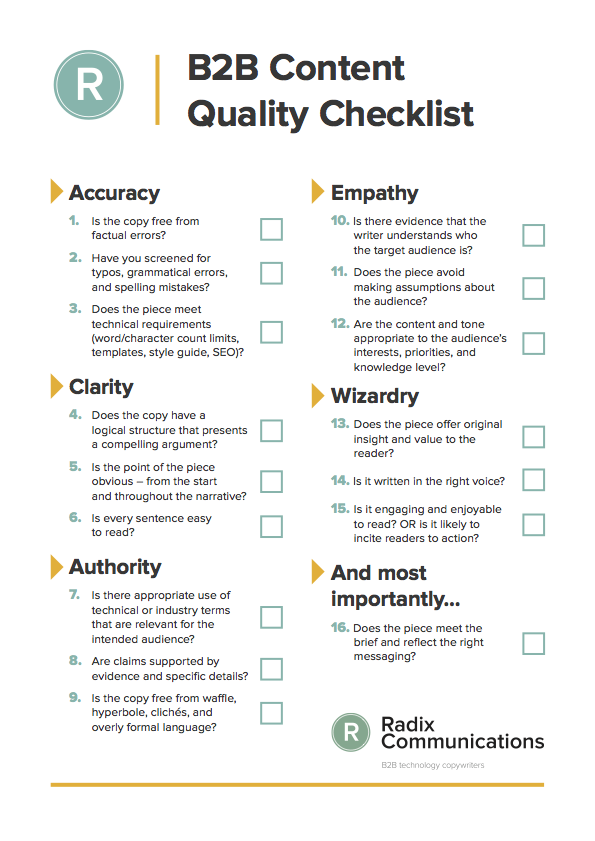In any industry where quality matters, there are a series of objective tests that a product has to pass before it’s released. But somehow, assessing B2B marketing content still seems to be a highly subjective process.
Maybe there’s a belief that creative work is exempt from objective judgement, or a fear of provoking arguments and resentment among writers and stakeholders. Still, nobody reviewing B2B writing seems to have a clear idea of what good looks like.
And that’s ironic. Because in most other contexts, a simple checklist of definable yes/no tests – making quality a little less subjective – is precisely the thing that prevents disagreement.
At Radix, we challenged the idea that evaluating writing is only ever subjective. So, we use a clear, 16-point QA checklist for all our internal reviews – the ones our content leads do before the client sees the work – and as part of our writer development programme.
Our checklist helps to safeguard quality, but it also improves consistency across our writing team by highlighting areas for development in both writers’ work and client briefs.
And it works so well that we want to share it with you.
(Click the image to open the checklist as a printable PDF)
A 16-point quality check for your B2B content
The questions we ask about our copy are grouped into five tests, reflecting the five key B2B copywriting competencies: accuracy, clarity, authority, empathy, and wizardry.
Test A: Accuracy
Q1: Is the copy free from factual errors?
Readers won’t take your content seriously if it’s littered with factual inaccuracies or (worse) straight-up lies. This is basic integrity.
Q2: Have you screened for typos, grammatical errors, and spelling mistakes?
Writers are only human, and typing is hard. But your reader may not be forgiving, so take the time to proof thoroughly.
Note: at Radix, as well as to safeguard quality, we use our QA to identify issues for development. So we need a scoring threshold that separates consistent errors from occasional slips. If you’re interested, our wording is: “Are there two typos or fewer per 500 words (100-250 words = <1 typo, <100 words = 0 typos) AND is the copy free from grammatical and spelling errors (that aren’t obvious typos)?”
Q3: Does the piece meet the technical requirements (word and character count limits, templates, style guide, SEO)?
This might seem niche, especially if you’re not writing for a client. The point to take away is that the copy needs to meet the technical requirements of the format.
Besides, if a client has a house style, it’s a basic courtesy to stick to it. And adhering to file-naming conventions makes managing content easier for everyone.
(So far, so good. The first three questions should ensure your copy is error-free. But we’re just getting started…)
Test B: Clarity
Q4: Does the copy have a logical structure that presents a compelling argument?
Usually, a B2B decision-maker isn’t interested in reading pseudo-intellectual subversion or meandering walls of copy. Your content can be long, but you must take your reader with you. That means you need a strong structure that always makes sense.
Q5: Is the point of the piece obvious – from the start and throughout the narrative?
If you’ve got to the end of the introduction and aren’t sure why you should continue reading, or if the piece completely tails off towards its conclusion, the result is the same: you’ve lost your reader – and your mark for this question.
Q6: Is every sentence easy to read?
If you find yourself rereading sentences, tripping over grammar, or referring to Google to understand the language, the piece won’t work. If your reader is a senior decision-maker, time-poor, or reading on a mobile device, that only adds to the pressure to ease the cognitive load.
The “every sentence” part of the question sets an incredibly high bar – B2B tech can be complex – but this is important, so we make no apologies for that.
Test C: Authority
Q7: Is there appropriate use of technical or industry terms that are relevant for the intended audience?
There’s no point claiming expertise if you don’t speak your reader’s language. If the content is for a specialist B2B audience, the writer will likely need to use relevant technical jargon where appropriate. And they’ll need to handle it correctly – too much B2B content sprays industry terms around to mask a lack of confidence, which always shows.
Q8: Are the claims supported by evidence and specific details?
Talk is cheap, so ensure every claim is specific and appropriately sourced. Don’t just say it’s fast; say how fast. Don’t say a viewpoint is widely acknowledged; link to an example. If there are references to studies or ongoing news stories, ensure the sources cited are the most recent available.
Q9: Is the copy free from waffle, hyperbole, clichés, and overly formal language?
Hyperbole fails when it promises the impossible (inflated language makes you less believable). If the writer seems too in love with their thesaurus, they might be making up for lack of relevant knowledge – and the reader knows that.
“If you care about being thought credible and intelligent, do not use complex language where simpler language will do.” Daniel Kahneman, Thinking, Fast and Slow
Test D: Empathy
Q10: Is there evidence that the writer understands the target audience?
This is fundamental to effective B2B marketing content. If the brief failed to define the audience, the writer should’ve pushed back before they even got close to writing.
Q11: Does the piece avoid making assumptions about the audience?
This is a tricky one. When you’ve done your audience research, it’s easy to go too far and lapse into telling the reader what they must think. Some writers will do this without realising, but making ill-advised assumptions only alienates the audience or dilutes the piece’s credibility.
Q12: Are the content and tone appropriate to the audience’s interests, priorities, and knowledge level?
How many B2B content pieces aimed at a particular sector start by defining the market or saying why it’s important? Newsflash: if you work there, you already know.
You need to understand your audience’s knowledge and awareness level. It’s partly about the language but also about being excited by the right things and going beyond features and benefits to understand the real difference a product, service, or idea will make to someone’s working life.
Test E: Wizardry
Q13: Does the piece offer original insight and value to the reader?
Not every piece needs to reinvent the wheel, but it does need to offer tangible value to the reader – and more content pieces fail on this count than any other. It might be new primary research, an original point of view, or a handy 16-point checklist (ahem), but the reader needs to gain something in return for their time.
Q14: Is it written in the right voice?
This is a little easier if you only write for one brand, but still, the piece needs to sound right. If you cover up the branding, is it still clear who’s speaking? Whether you’re writing on behalf of a brand or by-lining to an individual, reading should feel like the client is sitting in your head, dictating it to you.
Q15: Is it engaging and enjoyable to read? OR is it likely to incite readers to action?
Place yourself in the reader’s shoes. Does the end arrive quicker than you thought, or does it seem like hard work? Do you naturally want to take the next step, whatever that may be?
What interests this audience may bore you to tears, but if a piece is well written, you should be able to get to the end and say, “Yes, that would work for me if I was a slurry engineer.” If that’s the case, then hey, good stuff.
Q16: And most importantly… Does the piece meet the brief and reflect the right messaging?
After meeting all the points above, it’s important to consider whether the piece reflects the initial brief. If your answer is no, you must take a few steps back and identify where you went wrong.
Even if you’ve produced the most well-written blog post of the year, it won’t be useful to your client – or your campaign – if it doesn’t reflect what you set out to achieve.
If your content scores 16/16, it’s ready to go…
This checklist suits our needs as a team of B2B copywriters, reviewing each other’s work and writing across up to 100 B2B tech brands. And having reviewed thousands of pieces of content to date (from individual emails to messaging frameworks and entire websites), we find it’s working pretty well.
Your needs might differ; some questions could be more relevant than others. You may also have technical requirements that require greater nuance.
If that’s the case, feel free to download our B2B content scoresheet and make your own version. Maybe you’ll want to change the questions or weight the scoring somehow. Get creative.
But the point is this: asking clear, objective questions makes it much easier to tell whether your content works and reduces the number of arguments you’ll have about preferences. It can help you spot issues and change how you brief, write, and review. And ultimately, it’ll stop you from rushing out weak content.
If it helps to improve the quality of B2B tech content overall, then by all means, steal away. We’ll be delighted.




